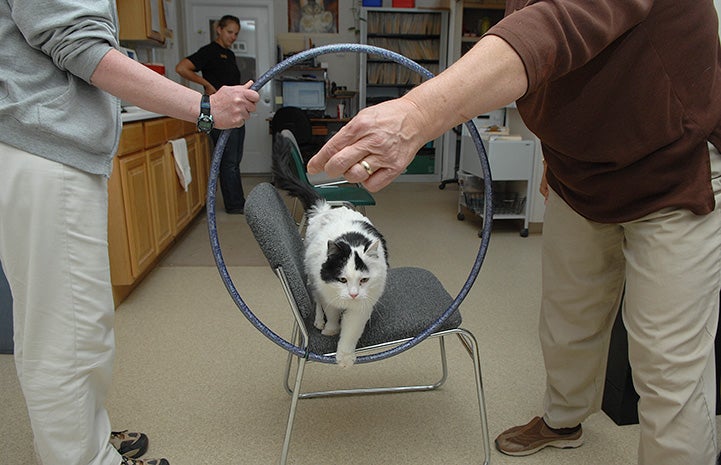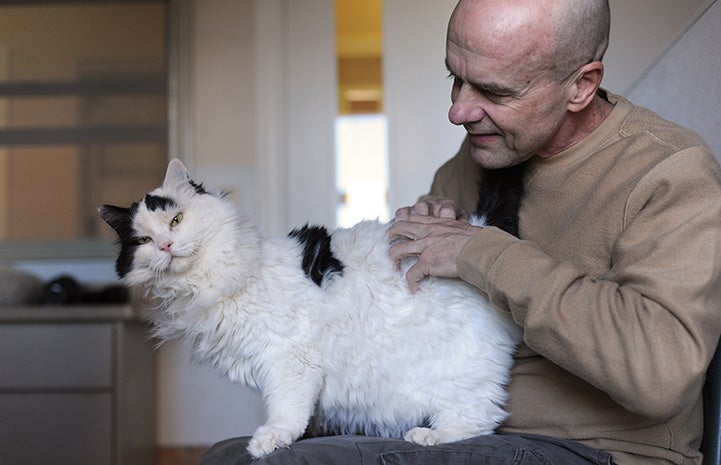Clicker training for cats

When it comes to clarity in conversation, a lot of times how you say something carries as much weight as what you say. With animals, in particular, we can communicate volumes without meaning to. We can quite literally say "good kitty" in such a way as to leave our cat wondering what he or she did wrong. That's where clicker training comes in handy.
Cat clicker training basics
The basic foundation to clicker training involves the animal associating something positive with the clicker sound — say, a treat or scratch on the back. Whatever motivates the cat.
Dr. Frank McMillan, director of Well-Being Studies at Best Friends, has been working on clicker training some of the cats at the Sanctuary. Among the many benefits clicker training provides, Dr. Frank explains that one huge plus is how clicker training techniques can transfer flawlessly from person to person because of the consistency of the sound.
"The sound will be able to carry over the exact same way," Dr. Frank says. "There’s no confusion in the mind."
That’s comforting to a cat.
Once the cat associates positive things with this specific sound, you can take advantage of the cat’s positive association by teaching the adoptive family to use the same sound. "It’s a great tool for adoptions," Dr. Frank points out.

Many uses of clicker training
Clicker training has multiple applications, from teaching tricks to correcting undesirable behaviors. "I don’t have any cats [at Best Friends], with all the wide variety of cases that they face, who can’t benefit in some way from clicker training," Dr. Frank says.
Consider Raed, a cat who has been challenging to trainers and caregivers for a long time. "Raed is my star pupil," Dr. Frank says. Raed has already learned to respond to seven different verbal cues in his training. "I can’t see any limit to what he can learn over time," says Dr. Frank.
And why is that so great?
Well, we’re not talking about teaching tricks just for the fun of it. There are powerful benefits to this stuff. Raed is the perfect example. He’s a cat who had a tendency to lash out when overexcited. Even by only rubbing up against you, Raed could get himself worked up to where he’d scratch or bite.
Clicker training gave him not only an outlet for all his mental energy, but a way out when he became too worked up. The first verbal cue Raed learned was "down," which meant he needed to hop down to the floor instantly.

Cats learn skills through clicker training
Guess what, though? Caregivers hardly ever need to use the "down" cue with Raed these days. "He has developed tremendous self-control," says Dr. Frank. "We can now pal around and play with him like a normal cat."
Now that Raed has a way to exercise his brain, he simply doesn’t get overexcited to the point of nipping or lashing out. "Clicker training really works their minds," Dr. Frank says. "They look forward to it so much."
Another success story is Sonny, a shy guy by nature. After going through clicker training exercises, Sonny now has no problems being approached by Dr. Frank or others. "It’s a really good confidence booster," Dr. Frank points out. "It puts them at ease."
Getting started with clicker training
While every cat can benefit from clicker training, Dr. Frank also explains not all cats are open to the work. As long as you can find something to motivate them, such as a treat or a back scratch, you’re golden. Yet if you have nothing they want, it’s hard to even get started.
For those who’d like to try clicker training with their own pets, one resource Dr. Frank recommends is the book "Clicker Training for Cats" by Karen Pryor. The only detail he likes to add is that this book doesn’t mention smartphones and their wide variety of clicker-type sounds, such as a ringing doorbell. Some cats prefer these sounds to a click.
Whatever sound you use, however, be sure and stick with it and your cat will thank you. After all, there's nothing quite like crystal clear cat communication.

Additional animal care and training resources
For information about general animal care and training methods, see the Best Friends Resources page.
Photos by Best Friends staff